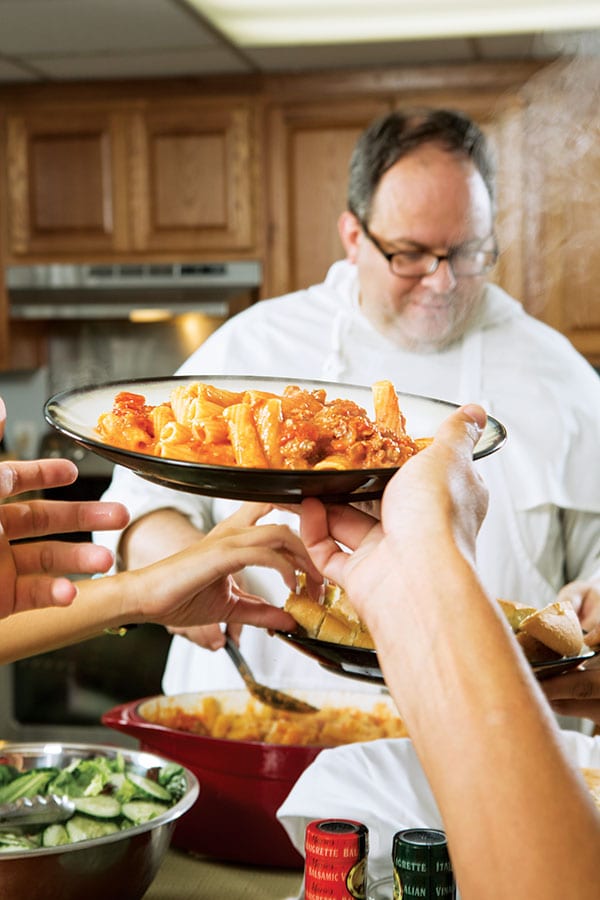Father Pivarnik: First Impressions and why I cook for students
By Rev. R. Gabriel Pivarnik, O.P.
In my eyes, Cam Walker could do anything.
At the close of the semester in the spring of 1987, before we had turned in our final Honors seminar papers, she had invited us to her home for a Saturday morning brunch. None of us knew exactly what to think. On the way to her house — a small Tudor cottage on Harrison Avenue, just a block or two off of the William & Mary campus — I caught up with Ilana and Debbie as they came out of Chandler Hall. They were dressed in their “church clothes,” and I was suddenly relieved that I had ironed my shirt and put on a tie. Debbie looked at me and said, “Do you have any clue what this is about?”
“Beats me. I just know there is food.”
The house itself was unassuming, much like Professor Walker. Her familiar bicycle, her only visible means of transportation over the last two years, was parked in what should have been her carport. As we reached the screen door and peered into the house, we could hear voices and see bustling movement inside.
“Come in, come in,” we heard. “Welcome!”
Some of my other classmates were already sprawled in various places across the room, some making it to the couch, two sitting in folding chairs that she had just carried into the room, and the rest happily on the floor. When the last person arrived, Professor Walker announced with glee, “OK, I think we are ready to begin.”
And with that, she sprung to the French doors at the far end of the room and opened them to reveal a feast waiting for us on the dining room table.
There were assorted pastries and jams, a piping-hot casserole dish filled with a quiche-like delight, bacon and sausage, freshly cut fruit, and an array of other culinary treats that must have taken days to prepare. You would have thought that none of us had eaten in days. We piled food onto our plates and sat back down in our places in the living room.
“There is one condition that comes with this food,” Professor Walker said. We didn’t care — she was feeding us real food. “We have to talk about our class,” she said.
“No problem,” I mumbled, through a mouthful of food.
We began to reflect on the semester we had just finished: the books that we had read together, the papers we had written, and some of the great discussions that we had that had continued long after class was over. As we talked, we realized how different we had become. It was as if the food we were sharing allowed us to see things in a new way.
Years later, I would realize how Eucharistic that moment was in the living room of my professor’s house. In the sharing of a meal, we had encountered something far greater than ourselves and had been changed. People often ask me, “Why do you cook for your students?” I usually don’t answer them completely. I just think of Cam Walker and the house on Harrison Avenue.
In the years that I have been at Providence College, I have surprised my students with homemade cookies, invited them to “Review-Session Pasta,” and gathered them together for formal dinners. My hope is that they feel as welcome as I did that day — and, with that sense of welcome, begin to open up their lives, their minds, and their hearts to each other. Then, the real learning begins.
Rev. R. Gabriel Pivarnik, O.P. is vice president for mission and ministry, director of the Center for Catholic and Dominican Studies, and an assistant professor of theology.
Father Pivarnik’s white chocolate and macadamia nut cookies
31/3 cups all-purpose flour
3/4 teaspoon baking soda
1/2 teaspoon salt
16 tablespoons butter (2 sticks ) — unsalted, softened completely
11/4 cups light brown sugar, firmly packed
1/2 cup granulated sugar
2 large eggs
2 large egg yolks
1 tablespoon vanilla extract (use a quality brand)
12 oz. white chocolate chips or chunks
1/2 cup macadamia nuts, crushed
1. Preheat oven to 325 degrees.
2. Mix flour, baking soda, and salt in a large bowl.
3. Using an electric mixer, beat butter and sugar together (on medium speed for about 2 minutes). Then, beat and add in eggs, egg yolks, and the vanilla until all are combined. You will probably need to scrape down the sides of the bowl as you do so.
4. Reduce mixer speed to low and VERY slowly begin to incorporate flour mixture, but for no more than 30 seconds. Don’t dump in the flour mixture at once or it may clump.
5. Mix in white chocolate and nuts.
6. Either spoon the dough out or roll it into large balls, and place on a baking sheet lined with parchment paper (for best results). Bake until edges are just golden — usually about 18-20 minutes. Rotate the sheets halfway through the cooking time.
7. Cool cookies on the baking sheets and then transfer to a wire rack to cool down all the way.
Makes just under two-dozen cookies, depending on how large you make them. My preference is for larger, 3½- to 4-inch cookies.
Tips:
• Make the dough ahead of time, roll it into logs, then wrap it tightly in plastic wrap. You can also separate the dough out into portions and freeze it.
• It is best to slightly undercook cookies — if you leave them on the baking sheet for 10-15 minutes, they will continue to cook slightly. This allows for a chewier cookie.
Comments on “Father Pivarnik: First Impressions and why I cook for students”
Leave a Reply
You must be logged in to post a comment.







I’ll have to try that recipe. 🙂